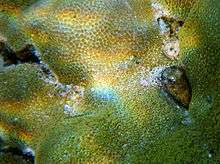Blennioidei
| Blennies | |
|---|---|
 | |
| Ophioblennius steindachneri | |
 | |
| Ecsenius axelrodi from East Timor | |
| Scientific classification | |
| Kingdom: | Animalia |
| Phylum: | Chordata |
| Class: | Actinopterygii |
| Order: | Perciformes |
| Suborder: | Blennioidei |
| Families | |
|
Blenniidae | |
The common name blenny (deriving from the Greek ἡ βλέννα and τό βλέννος, mucus, slime) is ambiguous at best, as it has been applied to several families of perciform marine, brackish, and some freshwater fish all sharing similar morphology and behaviour. Six families are considered "true blennies", all grouped together under the suborder Blennioidei; its members are referred to as blennioids. About 833 species are found in 130 genera within the suborder.
Blennioids are generally small fish, with elongated bodies (some almost eel-like), and relatively large eyes and mouths. Their dorsal fins are often continuous and long; the pelvic fins typically have a single embedded spine and are short and slender, situated before the pectoral fins. The tail fin is rounded. The blunt heads of blennioids often possess elaborate whisker-like structures called cirri. As generally benthic fish, blennioids spend much of their time on or near the sea floor; many are reclusive and may burrow in sandy substrates or inhabit crevices in reefs, the lower stretches of rivers, or even empty mollusc shells.
These fish are superficially quite similar to members of the goby and dragonet families, as well as several other unrelated families whose members have occasionally been given the name "blenny".
The six "true blenny" families are:
- Blenniidae: combtooth blennies, including the sabre-toothed blennies
- Chaenopsidae: pikeblennies, tubeblennies and flagblennies
- Clinidae: clinids, including the giant kelpfish
- Dactyloscopidae: sand stargazers
- Labrisomidae
- Tripterygiidae: threefin blennies
Timeline of genera

-
.jpg)
Salarias sinuosus, the Fringelip Blenny
-
Blenny hiding in a hole near Gilli Lawa Laut, Indonesia
-

Tasmanian Blenny in Port Noarlunga, South Australia
-

BulletHead RockSkipper in Kona
-

Marbled Blenny, Entomacrodus marmoratus in Kona
References
- "Blennioidei". Integrated Taxonomic Information System. Retrieved 4 April 2008.
- Sepkoski, Jack (2002). "A compendium of fossil marine animal genera". Bulletins of American Paleontology. 364: 560. Archived from the original on 2009-02-20. Retrieved 2011-05-19.




